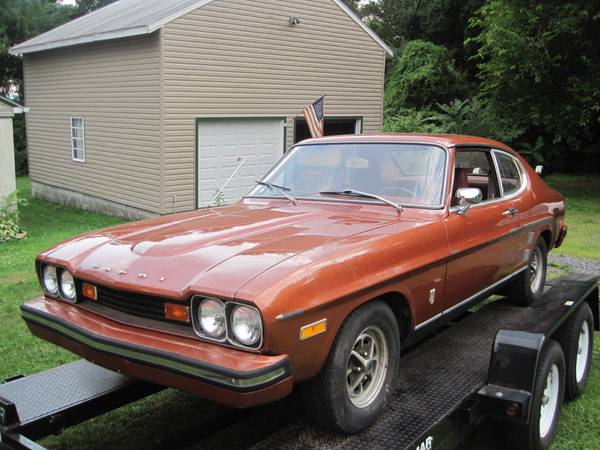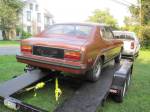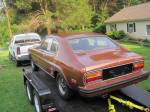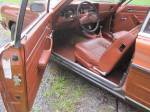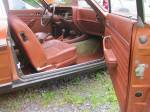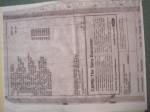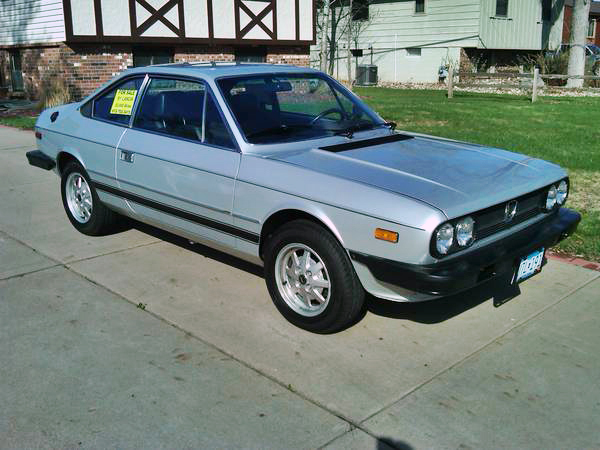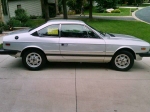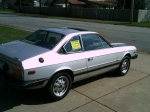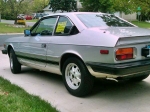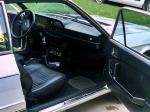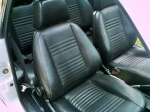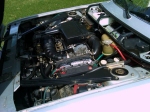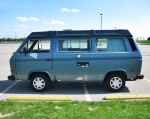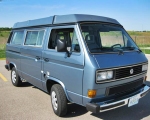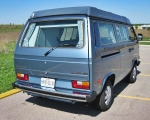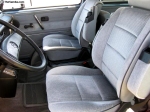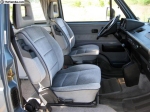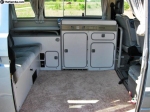The story of the Ford Capri is one not so much of invention as reinvention. With the immense success of the Mustang in the US, Ford identified that a pony car market could exist on foreign shores, namely Europe. Its project name was in fact Colt. Using the already sporty Cortina as a mechanical basis, Ford wrapped it in a handsome fastback coupé body. By the time of its introduction in 1969, the Mustang had grown into something closer resembling a draft horse than a pony. When the Capri went on sale in the US through Lincoln-Mercury dealers, the marketing boffins labeled it “The Sexy European.” This virtually insured that rather than recapture the spirit of the pony car of the mid-‘60s, it would instead be forevermore labeled a chick car. Having been established prior to the fuel crisis, it wasn’t until a few years later, when the Mustang II would replace its goliath predecessor (and itself be one of history’s chickiest of chick cars), that the Capri would be seen as a viable alternative to its European contemporaries from BMW, Fiat and even Alfa Romeo. Its dealer/service network was a huge bonus, but aside from that, it was a decent performer and a favorite or weekend autocrossers and gymkhanists. The US-version 2.8-liter motor was one of the most balanced, revvy, dependable V6s of the time. With a relatively-good-for-its-day 90-hp output, the smoothness of its delivery made the car feel much more powerful. The first-gen Capris would go on to sell reasonably well and merged seamlessly into their second reinvention as a more refined, cavalier (read: chick-y) twin to the Fox-bodied Mustang. The Capri name took a brief hiatus in the late 80s before being reinvented one last time as a front-drive roadster (befittingly, reclaiming its chick car badge) built by Ford Australia. Plagued by perceived quality and safety issues, the Capri finally came to rest in 1994. Today, however, we return to perhaps its most masculine iteration, the Mk I. And we do so in a good way, with a 62,700-mile example that has been remarkably preserved where others have literally crumbled from rust and neglect. Its àpropos ‘70s Copper paint has held up well, though there is a fair amount of oxidation on the leading edge of the hood. Inside, upholstery and dash look to be in nice shape with only some small tears in the driver‘s seat. Seller discloses some other issues need to be addressed, but the mere fact that one of these still exists in captivity, much less one that is original down to the clock, radio and window sticker, is undoubtedly worth a look. Find it here on Craigslist in Pennsburg PA for a reasonable $5,000.
Tag: window sticker
With a history nearly as long as the automobile itself, it is somewhat surprising that Lancia was never able to build a bigger presence in the US. Despite enthusiast and critical favorites like the Aurelia and Fulva, by the late 70s and early 80s, Lancia was competing in a congested GT market with the likes of BMW, Audi, Alfa Romeo, and Japanese marques, as well as parent company Fiat. Faced with perceived reliability problems (mostly derived from the US emissions-burdened carbureted cars) and anemic revenues, Lancia, along with the Fiat, exited the US market in 1982. That’s not to say they weren’t making nice cars. The cars were in fact nicer than their pricepoints allowed. The fuel-injected 2.0 Litre DOHC motor introduced in 1981 was better tuned to the emissions regulations and many of the reliability issues were alleviated in its last two years. Nevertheless, it was too little too late to turn a profit, despite needing export markets to keep volumes high enough to cost-justify their production in the first place. Whilst the US missed out on some of the exquisite Lancias like the Delta Integrale and Ferrari-powered Thema 3.2, we did get some interesting variations on the Beta platform including the mid-engine Scorpion and Targa-roofed Zagato, as well as the handsome 2+2 Coupé like the one presented today. With less than 55,000 miles put on by a single owner, it is as honest an example of a Beta Coupé as there has been on the market in some time. As a 1981, it has the original 120-hp fuel injected motor and five-speed gearbox. It wears its original silver metallic paint with no bodywork and only one small spot of rust disclosed. Black leather upholstery looks to be in stellar condition, as do the dash and carpets. This Beta Coupé is also well documented, including manuals, sales brochure and original window sticker. Though there aren’t many to track, prices for Beta Coupés are on par with their early 80s contemporaries like the BMW 320i and VW Scirocco, ranging from a couple thousand for cars needing some TLC to Concours-quality examples fetching five digits. Whether or not a Lancia Beta Coupé has the fan base to support it being investment-grade like the BMW or Scirocco remains to be seen, but it’s a unique Italian GT that can certainly be enjoyed in the meantime. Find it here on Craigslist in Lakeville MN for $7,500.
It’s hard to imagine that at some point in life, we haven’t all wanted a VW Camper. When you think about it, the mere idea of it—a mass-produced recreational vehicle that’s suitable for everyday use—holds enormous appeal and yet has no “market segmentation.” Volkswagen and Westfalia-Werke, an outfitter of camper trailers at the time, did it just because. It is inconceivable to think that it would ever get past a concept stage today. Yet, through generations of the Type 2 it’s based on—and more than five decades—Westfalia converted nearly half a million VW vans that were sold through Volkswagen dealers until the end of the official collaboration in 2003. This was clearly more than a cult following, though it was certainly every bit that and continues to be. Early split-window Westfalias in No. 1 condition can easily approach or eclipse six figures and the very capable Syncro versions of the T3 are close on their heels. That said, not many can be found in No. 1 condition and that is perhaps àpropos, as these were vehicles meant to get out there and get used. After the split-windows, kitting became quite ubiquitous through the generations. Aesthetically, there’s a styling choice between the more classic T2 (1968-1979), the boxier ‘80s T3 version (1980-1991) and the sleeker T4s (1991-2003). Although neither is what anyone would consider high-performance, engine choices evolved through the years from a traditional 1.6-litre flat 4 of the early cars (which steadily increased to 2.0 L) to the 200-hp VR6, with diesel and TDI versions as well. For those seeking a little less embarrassment on hills or in passing situations, they can be modified with turbocharged Subaru or six-cylinder Porsche powerplants without too much trouble. With that, we’ll turn our attention to today’s pick. It falls just about in the middle of the affordable Westy range, both in terms of year and price. It is in many ways the quintessential Westfalia. As a 1987, it has the slightly more powerful (and far less combustible) water-cooled 2.1-litre flat 4 producing a mediocre-but-ample 95 hp. It looks to be exceptionally clean with very little wear on both paint and upholstery. It has had a fair amount of recent service and with 91,000 miles, is considerably fresher than most. All the camp equipment (stove, refrigerator, sink, hookups, tables, swivel seats, etc.) is said to be in good working order and the canvas pop-top appears to be in excellent, waterproof, bugproof shape. The only flaws reported are two small rock chips in the windshield, passenger window converted to manual (driver is power), rear wiper motor, and once in a while an oil drip from the drain plug (not uncommon in horizontally-opposed motors). There are some lower-mile examples in showroom condition available through specialists like GoWesty or private party for $40K or more; there are many more well-used, high-mileage, devil-may-care ones that can be had for $10K or less. This appears to be a very complete (has the original window sticker), ready to enjoy Westy for reasonable money. Find it here on The Samba for $19,000.

- M40 – Turbo Hydramatic
- G81 – Positraction (3;08)
- J50 – Power Brakes
- U69 – AM/FM Radio
- A31 – Power Windows
- C60 – Air Conditioning
- A01 – Soft Ray Tinted Glass
- PT6 – Red Stripe Tires with Rally Wheels
- N40 – Power Steering
- Original jack
- T-Top bags
- Owners book with original bag
- Protect-O-Plate
- All California registation papers back to 1968.
